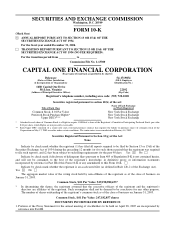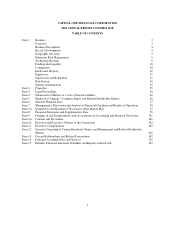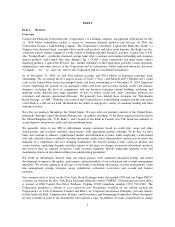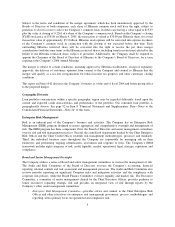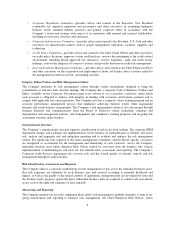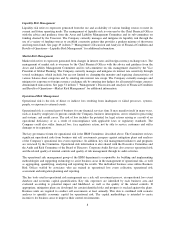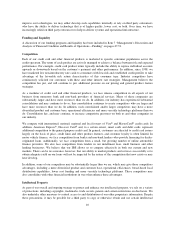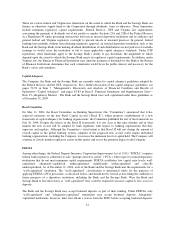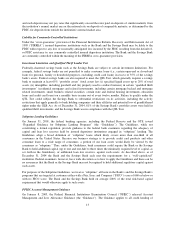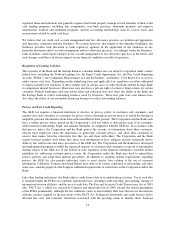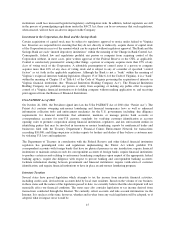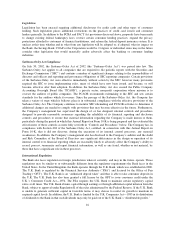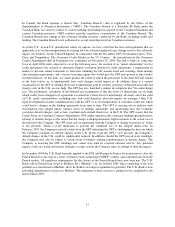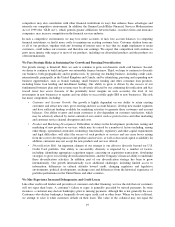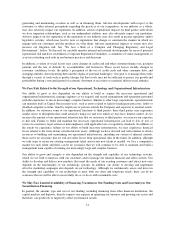Capital One 2004 Annual Report Download - page 34
Download and view the complete annual report
Please find page 34 of the 2004 Capital One annual report below. You can navigate through the pages in the report by either clicking on the pages listed below, or by using the keyword search tool below to find specific information within the annual report.property or proprietary information without authorization. Our precautions may not prevent misappropriation or
infringement of our intellectual property or proprietary information. In addition, our competitors also file patent
applications for innovations that are used in our industry. The ability of our competitors to obtain such patents
may adversely affect our ability to compete. Conversely, our ability to obtain such patents may increase our
competitive advantage. There can be no assurance that we will be successful in such efforts, or that the ability of
our competitors to obtain such patents may not adversely impact our financial results.
Employees
As of December 31, 2004, we employed 14,481 employees whom we refer to as “associates.” A central part of
our philosophy is to attract and maintain a highly capable staff. We view current associate relations to be
satisfactory. None of our associates is covered under a collective bargaining agreement.
Supervision and Regulation
General
On July 6, 2004, the Board of Governors of the Federal Reserve System approved the Corporation’s application
pursuant to section 3(a)(1) of the Bank Holding Company Act of 1956, as amended (the “BHC Act”) (12 U.S.C.
§ 1842(a)(1)) to become a bank holding company (“BHC”) as a result of the Bank’s proposal to amend its
Virginia charter to remove existing restrictions on its activities and thereby permit the Bank to engage in the full
range of lending, deposit-taking and other activities permissible under Virginia and federal banking laws and
regulations. The Corporation made this change to allow for a more efficient corporate structure and rationalized
funding base. On October 1, 2004, the Corporation registered as a BHC with the Federal Reserve and became
subject to the requirements of the BHC Act, including limiting its nonbanking activities to those that are
permissible for a BHC. Such activities include those that are so closely related to banking as to be incident
thereto such as consumer lending and other activities that have been approved by the Federal Reserve Bank of
Richmond by regulation or order. Certain servicing activities are also permissible for a BHC if conducted for or
on behalf of the BHC or any of its affiliates. Impermissible activities for BHCs include activities that are related
to commerce such as retail sales of nonfinancial products. The Corporation does not engage in any significant
activities impermissible for a BHC and therefore, does not anticipate a significant change in its activities as a
result of this change in legal structure.
The Bank is a banking corporation chartered under Virginia law and a member of the Federal Reserve System,
the deposits of which are insured by the Bank Insurance Fund of the Federal Deposit Insurance Corporation (the
“FDIC”). In addition to regulatory requirements imposed as a result of the Bank’s international operations
(discussed below), the Bank is subject to comprehensive regulation and periodic examination by the Bureau of
Financial Institutions of the Virginia State Corporation Commission (the “Bureau of Financial Institutions”), the
Federal Reserve Board (the “Federal Reserve”), the Federal Reserve Bank of Richmond and the FDIC.
The Savings Bank is a federal savings bank chartered by the Office of Thrift Supervision (the “OTS”) and is a
member of the Federal Home Loan Bank System. Its deposits are insured by the Savings Association Insurance
Fund of the FDIC. The Savings Bank is subject to comprehensive regulation and periodic examination by the
OTS and the FDIC.
The Corporation is also registered as a financial institution holding company under Virginia law and as such is
subject to periodic examination by Virginia’s Bureau of Financial Institutions. The Corporation’s automobile
financing activities, conducted by COAF and its subsidiaries, fall under the scrutiny of the state agencies having
supervisory authority under applicable sales finance laws or consumer finance laws in most states. The
Corporation also faces regulation in the international jurisdictions in which it conducts business.
Dividends and Transfers of Funds
Dividends to the Corporation from its direct and indirect subsidiaries represent a major source of funds for the
Corporation to pay dividends on its stock, make payments on its debt securities and meet its other obligations.
11


